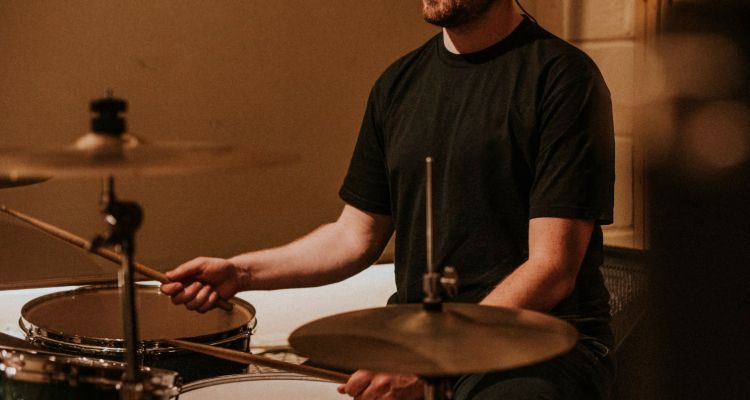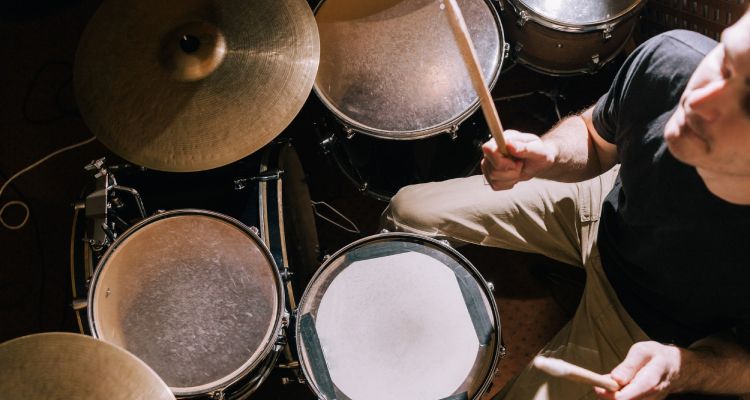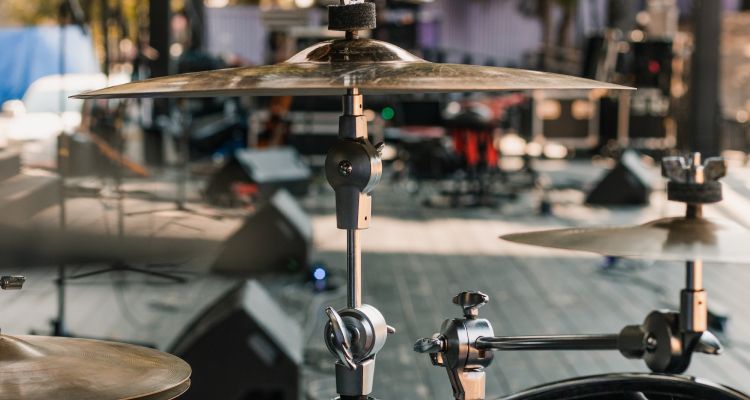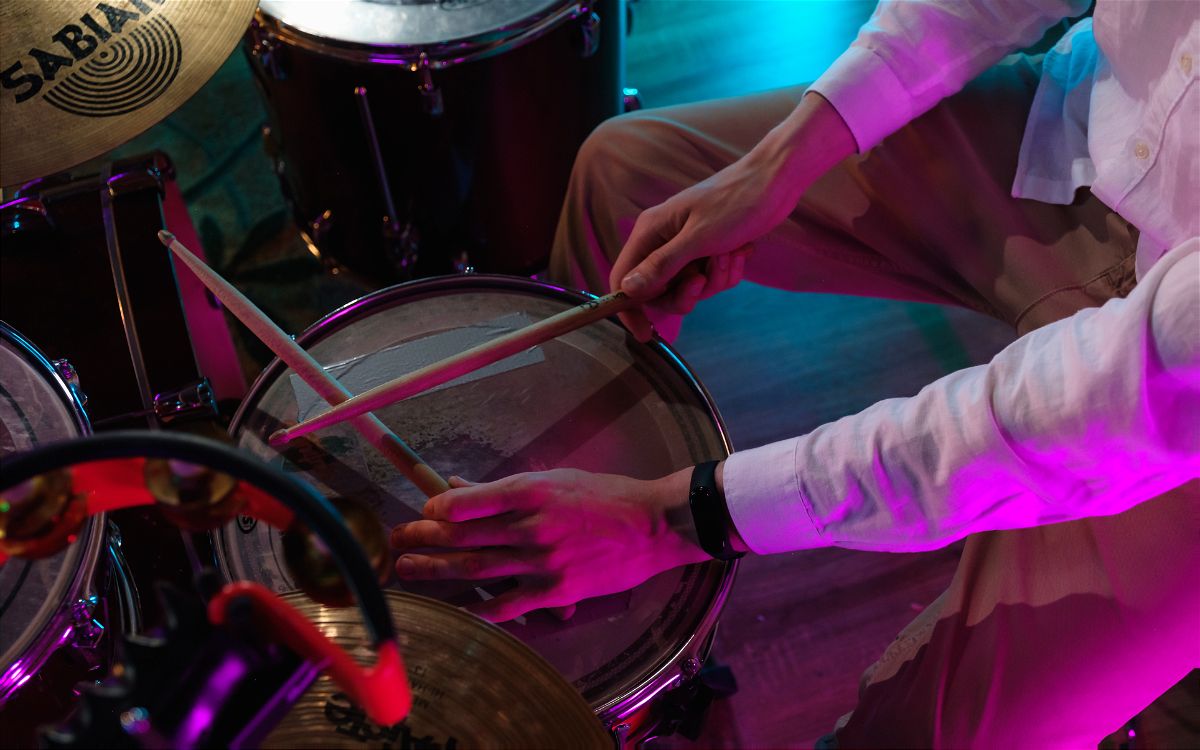As a drummer of 18 years, I know how challenging it may seem to start playing the drums.
Things can seem a bit overwhelming with thousands of online drum lessons and courses telling you what to do.
All those lessons are fantastic, but the key is to just play the drums. While you’re learning and playing, there are some things that you need to keep in mind.
In this article, I will share some of the top tips that I wish I had known when I was a beginner drummer.
Read on to discover some professional drumming tips that will ensure you’re getting the most out of your practice times.
Contents
- Gear Doesn’t Matter At First
- Learn How to Set Up a Drum Kit Comfortably
- Focus On Your Posture
- Hold Your Drum Sticks Correctly
- Strike the Center of the Drum Skin
- Don’t Bury Your Sticks Into the Drum Head
- Choose Whether to Play Closed or Open-Handed
- Employ Correct Bass Drum Technique
- Get Used to Playing with a Metronome
- Focus on Hand and Foot Independence
- Don’t Angle Your Drums Too Much
- Don’t Tighten Your Cymbals Too Much
- Master the Fundamentals
- Find Inspiration
- Pay Attention to Your Playing Volume
- Learn to Read Drum Sheet Music
- Understand Proper Cymbal Striking Technique
- Learn to Play Basic Rudiments
- Play With Other Musicians
- Develop a Practice Routine
Gear Doesn’t Matter At First
If you don’t have a drum set yet, it’s important to know that gear doesn’t matter in the beginning stages of drumming.
You should just buy whatever drum set you can, and then you can go through all the building blocks from there.
Many drummers believe that learning will be easier if they play on a high-end drum kit, but that couldn’t be further from the truth.
The first few years of drumming are when you won’t recognize sound quality yet, so make the most of them by purchasing affordable drum gear when you’re a beginner drummer.
Learn How to Set Up a Drum Kit Comfortably
Once you have a drum set, you should learn and understand how to set it up in the proper way. Over the years, drummers and drum companies have discovered the optimal way of setting up a drum kit.
If you follow the standard way of setting up a 5-piece kit, you should be able to feel quite comfortable when playing.
Having your kit set up in the standard way will also make learning things easier, as most drum teachers use standard setups when they’re teaching.
Focus On Your Posture

Good posture is vitally important for drummers. Your drumming posture is important for both your performance and your health. If you have bad posture while sitting at a drum set, it will likely lead to injuries down the road.
It can become easy to slant your back without being aware of it. That’s understandable, as beginner drummers put more focus on what they’re doing with their hands and feet.
Keep a straight back is important for playing the drums comfortably for many years to come. You’ll also want to keep your shoulders nice and relaxed whilst you play.
I find it also helps to sit higher up on your drum throne, so that your thighs slope down slightly toward your knees.
Hold Your Drum Sticks Correctly
There are a few recognized techniques for holding drumsticks. The main way of doing it is called matched grip. Within matched grip, you get German grip, French grip, and American grip.
You may hear drummers telling you to pick one, but you should just play the drums to see which one comes naturally to you. Once you have that, work on perfecting it.
Learning traditional grip will take a bit more time and skill. It’s not recommended for beginners unless they really want to use it.
Strike the Center of the Drum Skin

Accuracy is very important for drummers in terms of the location of where you strike the drumhead with the stick. Hitting the drumhead dead center will produce the best tones from the drum.
All the best drummers in the world play with the correct technique and strike the middle of the skins. So just remember to be aware of this while you play.
The stick marks that will naturally appear on the snare drum and toms will also help to reveal whether or not you are hitting the middle of the heads.
Don’t Bury Your Sticks Into the Drum Head
When you hit the drums with your sticks, make sure not to leave the sticks on the drumheads after you’ve finished your strokes.
If you leave a drumstick on the head, it will choke out the sound and stop the shell from vibrating. This kills the resonance.
A lot of beginner drummers do this while holding their pointer fingers along the drumsticks.
Always make sure to allow the sticks to bounce off the drumheads while playing to get the best tones out of the drums.
Choose Whether to Play Closed or Open-Handed

Closed-handed drumming refers to when you put your right hand on the hi-hat and left hand on the snare drum. This is the most common way that people play the drums.
Open-handed drumming refers to when your left hand stays on the hi-hat while your right one plays the snare drum. This is far less common, but it has many benefits.
It’s a good idea to pick a stance right at the beginning so that you develop the necessary skills early on.
Employ Correct Bass Drum Technique
You should also pick a bass drum technique in the early stages of your drumming journey.
The two ways of playing are heel-up and heel-down. When you play heel-up, it means only your toe rests on the bass drum pedal, and you mostly use force from your leg to play strokes.
When you play heel-down, your whole foot rests on the pedal, and you mostly use your ankle to play different strokes.
Get Used to Playing with a Metronome
A metronome is an essential tool that every drummer should be comfortable with. Metronomes keep you in time, and the job of a drummer is to be a timekeeper.
When you learn the first few beginner drum beats and fills, you should practice them along with a metronome at various tempos.
The more comfortable you get with a metronome, the better drummer you’ll become.
Metronomes also do a fantastic job of helping you learn things. When you play at a very slow BPM, you start to develop muscle memory. You can then slowly raise the tempo to get faster at a more efficient rate.
Focus on Hand and Foot Independence

One of the biggest struggles that beginner drummers have is separating their hands and feet. One of the best beginner drum tips is to focus on developing that skill early on.
Being able to comfortably separate your hands and feet will allow you to play countless beats and fills on the kit.
You may find that you struggle with a particular hand or foot, so focus even more on your weak points once you find them.
Don’t Angle Your Drums Too Much
One big mistake that many beginner drummers make is angling their drums too far toward them .
By doing that, you’re limiting the amount of force you can get behind each stroke. It also makes it much harder to strike the drums in the center to get the fullest tone.
It’s okay to have a bit of a forward tilt. In fact, that’s what you should have. Only a few pro drummers like their toms to sit completely flat. Just don’t overdo the forward lean.
Don’t Tighten Your Cymbals Too Much

If you make the wingnuts on the cymbal stands too tight, it stops the cymbals from freely wobbling around. That puts more pressure on the cymbals, as the vibrations have no way of getting offloaded easily.
This leads your cymbals to crack much faster than if they were rested on stands with looser wingnuts.
Master the Fundamentals
When learning to play drums, there are a few essential techniques that every beginner needs to go through and work on. These are basic beats, fills, rudiments, and standard playing techniques.
You’ll improve quickly if you stick to mastering those fundamentals before moving on.
They’re the foundation of drumming, so your playing may fall apart if you move on too quickly to harder things.
Find Inspiration
Do you remember who inspired you to start playing the drums? It’s a good idea to keep letting that person or band inspire you. It will motivate you to practice and improve to get to a higher level.
It’s also a great idea to watch famous drummers play and find a few favorite ones to repeatedly watch.
Inspiration is the best source of motivation, and having favorite drummers often encourages beginner drummers to aspire to be like them.
Pay Attention to Your Playing Volume
Volume is an important aspect of drumming. It is important to pay attention to your volume, especially if you are playing with other musicians.
You don’t want to overpower the other instruments in rehearsals and at a gig!
The style of music you are playing will also have an influence on your playing volume. For example, if you are at a rock or metal gig, you’ll find drummers tend to beat up their kit (like Travis Barker), whilst jazz drummers employ a more delicate technique.
This is why different types of drummers use varying drumstick sizes. Rock and punk drummers use heavier, thicker sticks like 5B or 2B whilst jazz or folk drummers use 7a or 5a sticks.
Learn to Read Drum Sheet Music

Knowing how to read drum notation is a skill that every drummer should have.
It opens up many opportunities, with the main benefit being that you can learn how to play something by simply reading a bit of notation.
Being able to read sheet music also gives you a better understanding of how subdivisions work. That will make it easier to create and learn different beats and fills.
Understand Proper Cymbal Striking Technique
I mentioned earlier that tightening wingnuts too much will damage cymbals. Another way of damaging your cymbals is by striking directly at them.
The best way to preserve your cymbals as much as possible is to strike them diagonally with a glancing blow so that you don’t send force through to the bell as you crash on them.
This takes a bit of practice, but it’s worth it when your cymbals last decades without cracking.
Learn to Play Basic Rudiments
The first three rudiments you should learn are single strokes, double strokes, and single paradiddles. The next few would be flams, drags, and ruffs.
Those six rudiments unlock a whole world of possibilities, so they’re the ones that beginner drummers should focus on the most.
It’s a good idea to learn how to play them leading with both hands. You should also play them in different timings and subdivisions.
Play With Other Musicians

Another one of the best tips for beginner drummers is to play with other musicians as much as possible. A drum kit is a musical instrument, and most instruments are meant to be played together.
Drum kits can’t make music themselves, but they can support a band with beats and rhythm.
Playing with a band will put all your skills to the test, and it will make you an overall better musician when you do it often. It’s hard to develop musicality skills if you just play drums on your own.
Develop a Practice Routine
One of the keys to effective practice is setting a regular schedule. This will help you develop a routine and build that valuable muscle memory. Here are some tips for setting a practice schedule:
Start small: If you’re just starting out, don’t try to practice for hours on end. Start with short sessions of 10-15 minutes and gradually increase the length as you build up your stamina.
Be consistent: Try to practice at the same time every day. This will help you develop a habit and make it easier to stick to your schedule.
Set goals: Before each practice session, set specific goals for what you want to achieve. This will help you stay focused and motivated.
Stay motivated: Find ways to stay motivated, such as by listening to your favorite drummers or watching videos of drum solos. This will help you stay excited about practicing.
Mix it up: Don’t just practice the same things over and over again. Mix it up by practicing different styles of music or working on different techniques.
Take breaks: It’s important to take breaks during your practice sessions to avoid burnout. Try taking a 5-10 minute break every so often.
By setting a practice schedule and maintaining consistent practice, you’ll be well on your way to becoming a proficient drummer!









